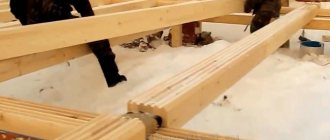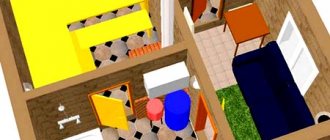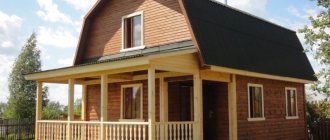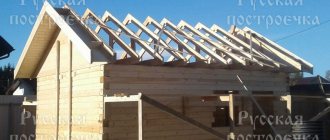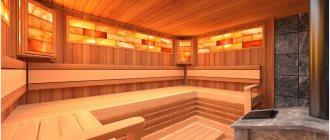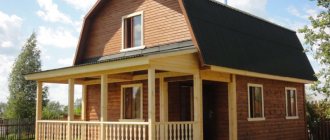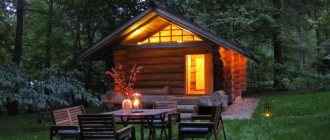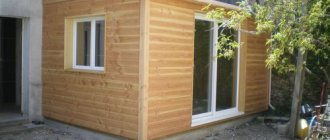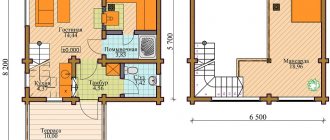House with sauna and garage. Teplokrepost Photos
They say that under the Union, in principle, it was not allowed to add a bathhouse to the house. And now, if all the rules and requirements are met, you can get permission and build.
However, take your time, below we will tell you about all the rules and requirements, the pros and cons of having a bathhouse attached to the house, and with this knowledge you will decide what is best for you.
And it’s better to start with bureaucracy.
Documents for construction permission
The first thing you need to know: the planned extension of a bathhouse to a house is considered a reconstruction of a residential building . And permission is obtained specifically for the reconstruction of a permanent structure (a residential building is a permanent structure).
However, a free-standing bathhouse is also considered a permanent structure, and permission must also be obtained for it. (Although not always, there is some kind of loophole that allows you not to take a construction permit , but then still register the already built bathhouse - in order to install electricity, water, gas there.)
House with sauna and terrace. Photo ProSIP
To obtain permission to reconstruct a residential building, you must go to the regional BTI . Take the following documents with you:
- a document confirming your ownership of the site (or a long-term lease agreement with the right to build);
- an application for reconstruction written by the owner of the site or an authorized representative (+ power of attorney for this person);
- general site plan;
- a renovation project that includes existing and planned buildings.
The package of documents will be reviewed within 10 days , and as a result, permission will either be given or denied. If permission is received, it is valid for 10 years. If it’s a failure, try a new project, taking into account the complaints.
What should you consider first? When a project is submitted, they will look at what building materials you indicated there . Therefore, you need to know the fire safety requirements (more about them below) and draw up a project so that it complies with all of them.
Now about registration. It is produced by municipal authorities. A completed construction is registered. This is done to secure ownership of it.
List of documents for registration:
- passport of the owner of the site;
- land ownership document;
- application for registration of a building, which contains the actual address of the land plot;
- design documentation for construction - with all building materials, dimensions, equipment and other details;
- a list of communications to which the building is connected, along with engineering diagrams.
IMPORTANT! Check with the BTI whether the reconstructed residential building with an extension will need to be registered, because it already has registration before the reconstruction. The above exactly applies to a free-standing bathhouse.
The design of a bathhouse attached to a house can be done independently or ordered from a design organization.
Extension to the bathhouse at home
No matter how funny it may sound, this option is also possible. For example, if we are talking about a guest house.
So, what standards apply if the owner of the site decides to add an extension to the house to the bathhouse? The bathhouse is a permanent structure , therefore a large-scale extension that makes it a residential building must also receive permission from the BTI.
Log sauna projects
A bathhouse made of rounded logs (standard and custom designs) is produced in the following dimensions:
- 5x4;
- 5x5;
- 6x3;
- 6x6.
Layout of log bathhouses 6 by 6
The classic one is a 6x6 m bathhouse made of round timber. Dimensions allow you to build a building with minimal wood waste. When using timber, finishing is not required; when laying the frame with logs, cladding using lining is required. The area allows you to equip a washing room, dressing room, and steam room in the room. When operating in winter, a vestibule design will be required.
Plan of a small log house for a bathhouse
A small wooden bathhouse has dimensions of 5x4, 5x5, 6x3 m. A veranda or porch can be attached to the building. A project with a 1st floor can be supplemented with an attic if necessary. Due to the small dimensions of the building, the shower room is often made a passage between the relaxation area and the steam room.
Typical projects
The advantage of standard projects is the accuracy of dimensions, designs, and planning solutions. Projects are optimized, shortcomings are eliminated, and the client receives a reliable building. Choosing a standard drawing allows you to save on development, building materials, and the work is completed in less time.
The design solutions take into account construction standards. The list of developed projects includes compact buildings, structures with swimming pools, verandas, an attic floor, and a glazed balcony. According to the project, a bathhouse made of rounded logs 6x6 m is created with a summer kitchen, a garage block, a billiard room and a recreation area.
Fire safety requirements
When you draw up different options for adding a bathhouse to your house, be guided by the following requirements set out in different standards (if you wish, you can find all of them online and read them in their entirety):
Lining made of unimpregnated larch for finishing
Thus, SP 4.13130.2009 states that a bathhouse or sauna cannot be built only in the basement, but on other floors it is possible, but on the condition that it will have a separate exit directly to the street.
NPB 106-95 “Individual residential buildings” states the following:
- fire partitions and ceilings should separate the bathhouse or sauna from the rest of the house;
- the stove must only be manufactured at the factory;
- the stove must have built-in automatic protection and a switch (we are talking about an electric one), which will work: 1) after 8 hours of continuous operation of the stove, 2) after reaching 110 degrees in the steam room;
- only hardwoods can be used in finishing the steam room (coniferous resin promotes combustion);
- placing a sauna in the basement is possible if there is a separate exit to the street.
ATTENTION! Do you see a contradiction between NPB 106-95 and SP 4.13130.2009 regarding the use of basements?
SP 7.13130.2009 “Heating, ventilation and air conditioning” states that it is necessary to install fire dampers where ventilation air ducts pass through fire partitions.
(This is necessary in order to prevent smoke from the ventilation during a fire. The valve is turned on when the temperature is high or when the fire extinguishing system is activated.)
The PUE “Rules for the construction of electrical installations” states the following:
- Hidden electrical wiring should not be used in wet rooms;
- It is forbidden to conduct wires in metal sleeves, sleeves and pipes and with metal sheaths;
- you cannot place plug sockets, distribution devices and stove control devices inside the steam room - all this is taken out to the next room;
- the wires must have a heat-resistant sheath designed for bath temperatures.
The wood-burning stove Harvia Legend 300 Duo in the interior of the steam room is located according to the rules. Harvia Photos
Without reference to a regulatory document, there are several rules governing the installation of a stove in a steam room:
- the distance from the stove to the wall is at least 20 cm;
- A heat shield is installed above the electric furnace, which is attached to the ceiling with a gap of 5 cm so as not to transfer heat to the casing.
In addition, the perimeter of the steam room located in the house can be equipped with perforated pipes, into which water is supplied only in case of fire.
The diameter of the tubes, the diameter and number of holes, as well as their location are selected so that at least 0.06 liters of water per second flow from a square meter of ceiling and walls. Typically, holes are made 3-5 mm, every 150-200 mm, the angle to the surface on which water is pouring is 20-30 degrees.
deluge irrigation system that is connected to the water supply. Its valve should be located outside the sauna. However, the requirement to install deluge pipes may not be followed because it relates to old standards.
Let's return to the point about fire partitions and ceilings. Partitions are not load-bearing walls, that is, they do not bear the load from the roof, and in this case they only serve as a barrier to the spread of flame.
So, the standards do not seem to prohibit you from building from what you like best - even from wood, but fire partitions must be strictly made of non-combustible material - brick or concrete blocks, but it is also possible from plasterboard.
ADVICE! Be sure to include them in your project to obtain permission.
What conditions should be created in the steam room?
Any steam room, regardless of type, should have:
- Thermometers (in no case mercury) to indicate the temperature inside the room and timely stop or reduce heating. This device must be installed at the level of a person’s head (170-180 cm) so that it demonstrates the maximum temperature that is created during vaping;
- Hygrometer – for monitoring humidity. In a Finnish sauna, a slight excess of water in the air is acceptable; in a Russian sauna, this figure should range from 40% to 60%.
- Good ventilation that will provide the right amount of fresh air. This system should consist of windows, ventilation ducts and doors.
Without the above devices and systems, the normal functioning of any steam room is impossible. Their absence can lead to irreversible consequences in the form of overheating, exceeding the maximum permissible humidity standards and problems with human health.
Combination options
Despite the fact that an extension seems like an obvious thing, it can mean three completely different options for adding a bathhouse to a house.
- You can make a connected foundation and use one of the walls of the house as a ready-made wall for a future bathhouse.
- You can make a separate foundation and not even use the wall of the house as the wall of the bathhouse, but combine everything with a common roof.
- You can make a bathhouse on your own foundation, with your own roof, a meter or more from the house, but connect the house and the bathhouse with a canopy, ensuring a quick and dry transition from one building to another. Or you can make a completely closed vestibule between them.
Strip foundation. Photo StroyDom
These options are far from equivalent to each other. It seems that if you use a common wall, you can reduce the amount of building materials , but below you will read about foundation shrinkage, and only after that start thinking about the benefits of this option.
As for the option with a common roof, it will only be suitable if you provide for the possibility of a hinged connection or any other that can compensate for the possibility of uneven movement of the two buildings as a result of frost heaving and other forces acting in the ground.
The option with a completely separate bathhouse and vestibule raises the least amount of concern about destruction associated with ground movement, the main thing is that this separate structure is recognized in the BTI as a reconstruction of the house, and not as a separate permanent structure that you placed next to the house.
Advantages of such a project
The main advantages of combined buildings of a bathhouse and a house include the incredible peace and comfort of the owners. There is no need to get dressed and go to the other end of the site, because everything you need is located nearby. This is especially true for those cases when you would like to take children to the steam room. After spending some time in the bathhouse, you can even walk from the bathhouse into the kitchen, bedroom or cozy living room with a fireplace and TV in a bathrobe and slippers. I would also like to consider this point. Often, the bath is used as the main type of treatment or prevention of numerous seasonal diseases. In this case, it will be much more convenient to have such a room in close proximity to the house.
You should not ignore the financial side of the issue, because combined buildings of this type imply the use of significant savings in the family budget. It is much easier to equip several rooms of a house for a bathhouse than to rebuild a full-fledged building for it. In addition, you don’t have to make a rest room, because for this you can use one of the rooms located in the house. The equipment of a dressing room and a steam room will be sufficient, since other amenities are already located nearby. Laying additional utility networks is also not required. The ability to save space also plays an important role, because if the site is small and there is no possibility to build a full-fledged bathhouse, there is always the possibility of combining buildings. Special costs for further maintenance will not be required, as is the case with a separate building. The ability to speed up the process of warming up and taking relaxing and wellness treatments. But this only applies if the separate bathhouse is not heated.
What you need to know about the foundation
Until you built the house, the soil underneath had the same properties, but the violation of its integrity, the pouring of the foundation, the load of the built house - all this changed them.
The zone within which a change in soil properties occurred does not exceed a couple of meters from the boundary of the building .
Stabilization of the soil after a house is placed on it lasts from 3 to 5 years. During this time, you should not place anything next to it, especially on a connected foundation.
Once it is established, you can build. But it is advisable that the project be carried out by specialists who can calculate how much weight the future extension will be, how much, on the one hand, it will sink the soil, and on the other hand, resist the forces of frost heaving, which tend to push the foundation out of the ground.
Of course, a lot depends on the soil itself . Some people are lucky and have sandy soil with coarse sand and gravel. And others have heaving clay, for example. Therefore, you need to know the geology of the site.
And the foundation for the extension of the bathhouse is selected according to the depth, design and material in accordance with the type of soil, the depth of groundwater, as well as the depth of soil freezing in winter. See the section on types of foundations.
ATTENTION! It is better if the groundwater is at least half a meter below the base of the foundation. If higher, then think about drainage.
This means that bathhouses are usually placed on a shallow strip foundation, but it is unlikely to be suitable for an extension to a house.
Firstly, because it is very desirable to build such a bathhouse from non-flammable material, and it weighs a lot , even if it is aerated concrete.
Secondly, because a shallow foundation is laid
above the freezing depth of the soil , and therefore, the forces of frost heaving will act more actively on it if the soil is heaving.
And it is better not to consider options for connecting the bathhouse to the house through the foundation or just the roof. Everything is fine when the foundation is laid at the same time and for both buildings at once. Therefore, it is recommended to pour the foundation immediately, taking into account all subsequent additions, if they are planned, and to implement them as funds and other opportunities become available.
If the foundations are laid at different times, and even more so at different depths, then their vibrations in the ground will not coincide in any way. It follows from this that it is best not to make a connected foundation of the house and extension.
But what's wrong with a single roof? If two foundations rise to different heights, but at the same time have a common roof, stresses will arise in the roof, which will lead to the destruction of the most stressed structural parts .
It is easier to add a bathhouse to an old house. It’s also easy to get to a house with a wide, warm blind area. In both cases, changes in the soil around the house will not have the same effect on the foundation of the bathhouse.
ADVICE! Of course, we have simplified a lot here, but the best thing you can do for yourself is to talk to specialists. So the project will be competent, the BTI will accept it, and there will be no need to expect destruction over time.
Visiting rules
To benefit from steam room procedures, you need to know how to steam properly.
There are not so many such rules and remembering them is not at all difficult:
- For the first entry into the steam room, 5 minutes is enough.
- Before entering the steam room, you need to douse yourself with warm water and wipe yourself dry with a towel. There is no need to wet your head.
- You need to start steam procedures from the bottom shelf.
- After 10 minutes in the steam room, you need to get out, douse yourself with water and rest for about 7 minutes.
- After resting, you can continue to steam, patting yourself with a broom.
- It is not recommended to make more than three visits to the steam room and stay in it for more than 15 minutes at one time.
- Drink water between sessions.
- After the bath, take a cool shower or plunge into the pool. A good sign during cooling will be a pleasant tingling sensation throughout the body.
- Enter the parameters of your sauna or simply leave a request
- We will receive an estimate for your project from each of our contractors
- We will choose the best offer and contact you
- You will get a sauna at the best price
Your promo code: “Sauna for you”! Tell it to our employee and the surveyor’s visit will be free for you.
Bathhouse attached to the house: pros and cons
House with a bathhouse and a terrace (gazebo). Photo by Uralekodom
If the owner managed to go through all the thorns to realize his dream, then what is a plus and what is a minus in a bathhouse attached to the house?
Pros:
- At the construction stage, there is no need to stretch communications far, everything is nearby.
- At the operating stage, it is also clear that the proximity of the bathhouse is only a plus: it’s easier to keep track, everything is at hand, and there’s no need to freeze when running into the house.
Minuses:
- If a bathhouse burns down 12 meters from the house, you will only lose the bathhouse. If the bathhouse is in the house, you can lose the whole house.
IMPORTANT! One of the common causes of fire, which for some reason is rarely remembered, is a sparking chimney. Install a spark arrester, and it is advisable to choose non-flammable roofing material for the bathhouse.
- The second important disadvantage is that bath procedures increase the humidity in all rooms of the bath itself.
When you sell a house with a bathhouse extension, using, for example, the wall of a residential building as an extension wall, you need to keep in mind that it will be affected by the excess humidity of the bathhouse. Therefore, it is better to immediately take care of its protection or choose a project without using the wall of the house.
What exactly might the defense consist of? First of all - in ventilation. Focus on it, and most of the problem will be solved.
Roof features
If everything is clear with the foundation, then is it possible to build a bathhouse under one roof close to the house?
From a safety point of view, it is better to equip each building with a separate roof if the buildings are separate buildings. During subsidence, there will be no load on the floors. But this will require additional financial costs. Buildings with a common wall or located close to each other can be combined under a common pitched roof.
Regardless of how the roof is positioned. It must comply with safety standards. It is necessary to cover all wooden elements of the floors with protective impregnation, take care of insulation and waterproofing.
Material options
Brick, frame, block, wood
From the list given in the title, probably the most preferred materials are brick and concrete blocks.
Of course, we said above that the BTI will pay attention to the choice of partition and ceiling materials, and not to the wall material, but where is the guarantee that this will be enough, that the partitions and ceilings will save a bathhouse that caught fire?
On the other hand, even a brick bathhouse attached to a house is lined with clapboard inside, because the bathhouse interior is associated primarily with wood.
If wood in the bathhouse cannot be avoided, then wherever possible it is worth impregnating it with fire retardants - substances that prevent wood from burning. Unfortunately, it is not advisable to use them in a steam room.
In general, we think that a frame or wooden extension to a house is unlikely to be allowed (if you have experience of the opposite, write in the comments, it will be useful to other readers).
Extension to a wooden, brick, block, frame house
But this is another interesting question: will it be allowed to add a bathhouse to a wooden or frame house, that is, when the residential building itself is a fire hazard?
We were unable to find standards that would specify the material of the house that can be reconstructed by attaching a bathhouse to it. But there is a rule that says that if two buildings are made of wood, then the distance between them should be 12 meters!
If you have experience in building such a fire-hazardous extension, such as a bathhouse, to a wooden residential building, write in the comments - how did you get permission, were there any requirements from the BTI, firefighters?
The remaining materials from which a residential building can be built do not cause concern - bricks and blocks do not burn.
As for the technical side, the wall material matters only from a design point of view, so it is recommended to make the extension from the same material as the main structure - for unity of style, and for construction it is more important what kind of foundation and roof - for the reasons described above.
Flaws
Disadvantages will be present in any case, even if there are few of them or they are insignificant. Fire safety is one of the most significant and main disadvantages of such an undertaking. This is why most people refuse such combinations. There are also a number of other nuances that may affect the decision:
- insurance companies often refuse to insure housing of this kind, because its level of safety is several times lower than that of ordinary residential buildings (and our insurance is compulsory);
- if all requirements are not met, even utility companies can reasonably refuse to provide their services (gas supply);
- After completion of construction work, you should visit many authorities, but they will not allow you to arrange this type of premises.
Terrace attached to the house: patio near the bathhouse
We spoke quite thoroughly about the terrace attached to the house in this article.
But now we are talking about an option when the extension forms a courtyard, which is called a “patio”. For some reason, it has become fashionable to call an open veranda with an earthen floor this very word, although the patio there is only an earthen floor, everything else is like an ordinary open veranda.
If the distance between the house and the bathhouse is small (we hope the standards are met) , then the terrace attached to the house can become a patio near the bathhouse, that is, you can move to it to relax after bathing procedures.
The difference between a terrace and a veranda is not very big; here is another link to an article about a veranda attached to an existing bathhouse, and another to an article that describes projects with extensions built into them.
Internal equipment
Properly selected equipment will help make bathing procedures as comfortable as possible. The selection of furniture and accessories depends on the taste preferences of the bathhouse owner. The main thing is that the equipment and interior decoration comply with fire safety standards and are made from environmentally friendly materials.
Useful video
Here is an example of the fact that it is still possible to attach a frame bathhouse to a house - we had no doubt about the technical reality of this, but the video says nothing about the resolution. This extension looks like this:
And here is another video that shows some techniques that can increase the fire safety of a bathhouse attached to a house. See if something from another person's experience will be useful.
The following video was recorded by a professional builder with a decent amount of work experience and the mental activity associated with it. That's why it's valuable. See if you also tend to think carefully about your decisions before getting down to business.
*** When writing this article, we encountered gaps in knowledge about the legal part of construction. Like most land owners, we believed that garages, bathhouses, sheds and verandas were the owner’s personal business. It turned out that the state thinks differently. It’s very interesting how many of our readers knew about permits and registration of buildings, sign up below if it’s not difficult!
Ready-made solutions for extensions
Separately, I would like to mention ready-made solutions for extensions to a bathhouse or house. The versatility and presentable appearance of monolithic and cellular polycarbonate have led to its widespread use. Now there are many companies on the market that offer ready-made metal structures and their polycarbonate cladding. Such buildings do not require a strong foundation, as they have little weight. The use of polycarbonate is also possible when building an extension based on a wooden frame. Such designs are distinguished by lightness and constant light, and in the evening you can enjoy the stars and the moon, because roofing decking is also made of polycarbonate.
Design
The design of an attached bathhouse has certain features. This stage should be carried out very thoughtfully, since the comfort and practicality of the future structure depends on it.
The first thing you need to decide on is the shape of the building and its location. Will the bathhouse have a common wall with the house, or will the 2 buildings be separated by a small vestibule?
Finished projects
If the owner’s plans do not include the construction of a non-standard structure, then a factory-made structure can be installed in a separate room. It does not require wood fuel, but is heated by an electric boiler.
Independent design
Drawing up a project yourself requires a thorough study of construction technology. These norms cannot be violated even in an effort to increase comfort.
It is recommended to take into account the specific construction conditions, plan the number and size of premises, their location and the transition between buildings. The design of the base depends on how exactly the extension will be made.
How to install it yourself
Craftsmen who like to do everything with their own hands will most likely be happy to undertake the expansion of the bathhouse area by adding a terrace. This is not difficult to do if the project is simple enough.
Let's take a step-by-step look at the options for how you can arrange the foundation, walls and roof of your terrace. If you decide to give up some elements, don’t worry, it will be easier, you’ll do it faster.
Foundation
IMPORTANT! The foundation is determined by the soil.
What does it mean? If you have already built a house and a bathhouse, then you know the geology of your site, you also know how heaving your soil is, that is, whether it will lift the foundation during freezing or not.
Heaving soils are those that have a lot of clay in them. The more sand there is in the soil, the calmer it behaves during frosts.
So, shallow foundations (above the freezing depth) are recommended where the heaving of the soil is low (sand). Otherwise, even for a terrace you will have to deepen the foundation below the freezing depth.
Strip foundation
And since we are talking about a late extension, that is, the bathhouse already has its own foundation, and you decided to add a terrace, then you don’t need to connect it with the bathhouse, and especially if it also differs in type or depth.
So, make a separate foundation of any type, the main thing is that it supports the weight of your structure - the entire floor, walls and roof, plus snow.
The main thing is to focus on the type of soil and deepen the foundation correctly. Because you really need it to not “walk” if you are making a common roof, for example. Even if the foundations are separate and move independently, and the roof is common, there will be problems.
Walls
Walls near the terrace are, of course, rare. And even if they exist, they will be more like partitions than full-fledged walls of the thickness needed for winter.
Bathhouse with a terrace with pillars. Photo by Uralekodom
Therefore, let's assume that in most cases the load from the roof is transferred to the foundation through supports - racks, columns or pillars. And if there are walls, they are light.
In this case, the cross-section of the supports will also have to be calculated, as well as the foundation. Don’t skip this step; do the calculations yourself using online construction calculators, or trust the specialists.
In general, two options emerged: with the roof supported on one of the bath walls and without it.
But now we are talking about walls and supports, so in the second case the number of supports will double. However, this may be a reasonable solution if the soil is mobile and the foundation has not been properly buried.
What to do if you decide to make the extension yourself? Leave a gap of several centimeters between the terrace and the bathhouse. And then fill this gap with polyurethane foam. Just remember to paint or cover it so that the foam is not destroyed by ultraviolet radiation.
Roof
Let's look at the options again. If the extension is located perpendicular to the length of the ridge, then you can extend the roof along the gable - lengthen the ridge, add rafters, support them on the frame, and it on the posts. In this case, the roof is single.
The second option is when the extension goes along the ridge. In this case, the fastening can be either on the mauerlat of the bathhouse, but this will require partial disassembly of the roof. However, you will have to disassemble it anyway, because most likely you will have to cut the overhangs.
So, either you put the rafters on the bathhouse’s mauerlat, or secure them in U-shaped brackets. The brackets are attached to the wall using anchors, forming a reliable support for the rafters (of course, the U is inverted). In both cases, you need to be sure of the foundation.
BY THE WAY! An alternative to modern brackets is to make grooves in the wall, but this is still a thing of the past. Another option is to fasten the beam along the wall with anchors, and place the rafters of the terrace on it and secure it with corners.
It was said above that along the ridge you can also build a shed roof, which continues (albeit at a different angle) the slope of the bathhouse roof, or you can make a gable roof that will be perpendicular to the ridge of the bathhouse. In this case, the terrace must inevitably have its own reliable Mauerlat or top frame.
IMPORTANT! Don't take risks with general roofing unless you're confident in the foundation.
Again, we have detailed materials on the construction of single-pitched and double-pitched roofs - we recommend that you read it if you want to do everything yourself.

